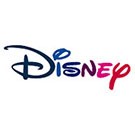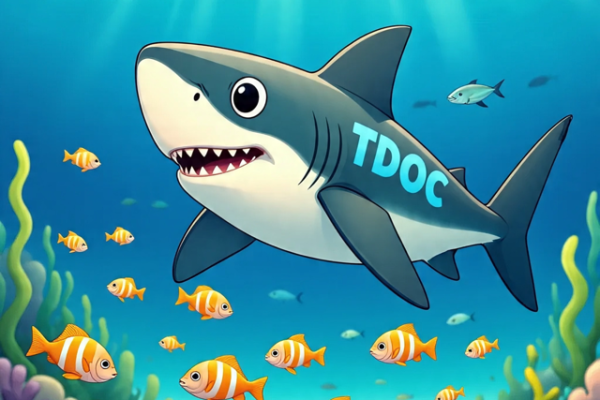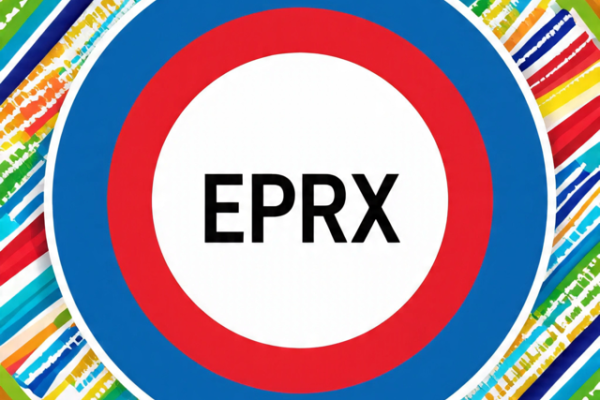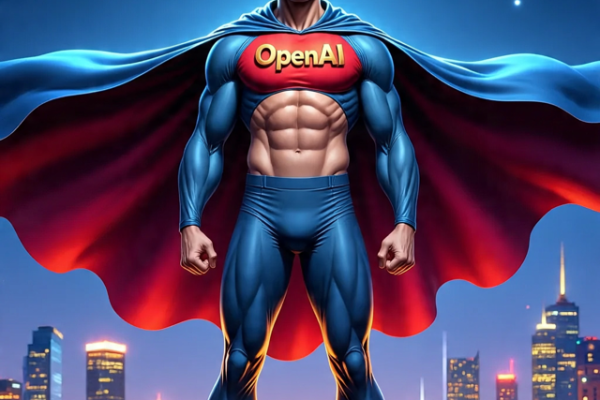“The advance of technology is based on making it fit in so that you don’t really even notice it, so it’s part of everyday life.” – Bill Gates, American – Businessman Born: October 28, 1955
The first day of the year for the market began and ended quite firmly in the green. Both the S&P 500, which closed at 4,796.56 (+.64%) and the Dow 30, which closed at 36,585.06 (+.60%), set record highs. The Nasdaq also closed strongly at 15,832.80 (+1.20%). However, a majority or 6 of the 11 sectors closed in the red. Curiously, the strength of the day was found in the minority, but they were with in the highly weighted sectors, The energy sector umped 3.1% with oil prices closing at $76.05/bbl, +1% to lead all, but the consumer discretionary sector up 2.8% & the financials and information technology sectors moving up 1.2% showed strength too. Singular strength was also derived from a few household names i.e. Amazon (AMZN, $3408.09, +2.2%), Apple (AAPL, $182.01, +2.5%) and Tesla (TSLA), which closed at $1,199.78, up a whopping 13.5% after reporting that they achieved production of more than 305,000 vehicles and deliveries of over 308,000 vehicles in Q4 & that in 2021, they delivered over 936,000 vehicles, thus beating expectations.
The small caps on the Russell 2000 also followed the large caps positive move with an even stronger advance closing at 2,272.56 (+1.21%). The MicroCaps also closed the day significantly in positive territory as the iShares Micro-Cap ETF (IWC) closed at $142.34, +1.87%. Bids were back in for the micros to some degree and they were not being met by tax selling, producing what may some may call the “January effect.” The SPDR S&P Biotech ETF (XBI), a barometer of the smaller biotech stocks, also moved higher to close at $115.44, +3.11% near the high of the day. The 52-wk range is $106.88 – $174.79. This biotech sector, particularly the small biotech, feel ripe for a strong move in Q1 after the beat down it took last year.
The macroeconomic schedule produced a couple of interesting reports again today, as the total construction spending report showed a .4%M/M rise in November, while the total private construction report showed a .6% M/M rise, & total public construction spending fell by .2%. Now on Y/Y basis the total construction spending was confirmed to be up 9.3%. The preliminary December IHS Markit Manufacturing PMI report confirmed a drop to 57.7.
The yield curve rose as the 2-yr yield closed up 6 basis points at .79% & the 10-yr yield finished up 12 basis points at 1.63%. The U.S. Dollar Index moved higher by .3% to 96.21, gold prices closed at $1,804/oz., -$12/oz., silver closed at $22.92, -$.18, Bitcoin (BTC) closed at $46,302.62, -2.21% over the past 24-hours.
VP WATCHLIST UPDATES
Apple (AAPL) closed at $182.01, +2.5% after hitting intraday high of $182.88, a new record intraday high. Apple is now the first company to achieve a $3T market cap.
As mentioned, Tesla (TSLA) closed at $1199.78, +13.53 after reporting that they achieved production of more than 305,000 vehicles and deliveries of over 308,000 vehicles in Q4 & that in 2021, they delivered over 936,000 vehicles, thus beating expectations. A Wedbush sell side analyst Dan Ives stated recently that he thinks Tesla shares could be headed to $1,800.
The Walt Disney Company (DIS) closed at $156.76, +1.21%. Disney will hold its annual meeting of shareholders on Wednesday, March 9, 2022 at 1:00 p.m. ET / 10:00 a.m. PT by virtual meeting and will be made available via webcast at
www.disney.com/investors.

On the small side, Atossa Therapeutics (NASDAQ: ATOS), a clinical-stage biopharmaceutical company seeking to develop innovative proprietary medicines in oncology and infectious disease with a current focus on breast cancer and COVID-19, rose to an intraday high of $1.78 prior to closing at $1.74, +8.75% on 3.356M shares of trading volume. On Dec. 22,
Atossa announced that it has initiated enrollment of its Phase 2 clinical study of oral Z-Endoxifen in Sweden. Participants in the study will be premenopausal women with elevated mammographic breast density, which is an emerging public health issue affecting more than 10 million women in the United States and many more worldwide. “
This is an extremely important milestone as it marks the next phase of developing our proprietary Z-Endoxifen,” said Steven Quay, M.D., Ph.D., Atossa’s Chairman and CEO.
“This study will help determine the relationship between daily doses of Endoxifen and reduction in breast density and will help us further assess safety and tolerability. We look forward to providing progress updates as they become available.” Physician-Scientist and CEO of Atossa, Steven Quay, MD, PhD, recently published an e-print on his research into a new coronavirus, named BANAL-236, reported by the Institut Pasteur in September 2021. At the time, BANAL-236 was the first bat coronavirus with high homology to SARS-CoV-2 that could directly infect human cells using the same receptor that SARS-CoV-2 uses. The new research reports that BANAL-236 has evolved the ability to infect human cells by an unknown mechanism that violates over 40 years of coronavirus research.
The COVID-19 e-print is available here and has also been submitted to Nature.
“When I read the paper from the Institut Pasteur and looked at the virus, I immediately assumed there was an error in either the way the sequence was assembled or a mix up in the lab with another virus to explain the infectivity,” Quay said. “
I contacted the Institut Pasteur with my findings and was deeply disturbed to learn that there was not, in fact, some simple mistake had occurred to explain things. I now knew we were in uncharted waters with a virus that is missing eight key elements that have been shown, over 40 years of research, to be required for growth.” Atossa management also recently presented at
“A Town Hall Q&A Event With Atossa Therapeutics Management Team” with Tribe Public.
You can view it clicking here. Atossa also announced recently that it had completed a pre-investigational new drug (PIND) meeting with the FDA to obtain input from the FDA on pre-clinical, clinical, manufacturing and regulatory matters in the U.S. for Atossa’s proprietary Z-endoxifen to treat breast cancer in the neoadjuvant (prior to surgery) setting.
On Dec. 13, Fate Therapeutics, Inc. (NASDAQ: FATE), a clinical-stage biopharmaceutical company dedicated to the development of programmed cellular immunotherapies for patients with cancer, showcased positive interim Phase 1 data from the Company’s FT596 program for patients with relapsed / refractory B-cell lymphoma (BCL) at the 63rd American Society of Hematology (ASH) Annual Meeting and Exposition. FT596 is the Company’s off-the-shelf, multi-antigen targeted, iPSC-derived natural killer (NK) cell product candidate derived from a clonal master induced pluripotent stem cell (iPSC) line engineered with three anti-tumor functional modalities: a proprietary chimeric antigen receptor (CAR) optimized for NK cell biology that targets B-cell antigen CD19; a novel high-affinity, non-cleavable CD16 (hnCD16) Fc receptor that has been modified to prevent its down-regulation and to enhance its binding to tumor-targeting antibodies; and an IL-15 receptor fusion (IL-15RF) that augments NK cell activity. “The interim dose-escalation clinical data from our FT596 program in relapsed / refractory B-cell lymphoma demonstrate that off-the-shelf, iPSC-derived CAR NK cells can bring substantial therapeutic benefit to heavily pre-treated patients in urgent need of therapy, with high response rates and meaningful duration of responses,” said Scott Wolchko, President and Chief Executive Officer of Fate Therapeutics. “We are particularly pleased with the therapeutic profile that has emerged with FT596 in combination with rituximab, where over half of the patients treated with a single dose of FT596 at higher dose levels achieved a complete response with a favorable safety profile that is clearly differentiated from CAR T-cell therapy. We look forward to assessing a two-dose treatment schedule for FT596 to further define its potential best-in-class therapeutic profile and ability to reach more patients, including those earlier in care.” Shares of FATE closed at $60.28, +3.03%.
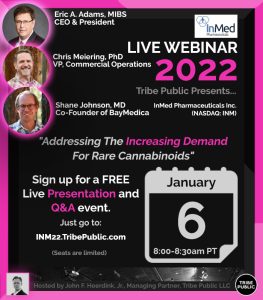
InMed Pharmaceuticals Inc. (NASDAQ: INM), a leader in the development, manufacturing and commercialization of rare cannabinoids, closed at $1.36, +3.82% after hitting an intraday high of $1.41. On Dec. 30, InMed announced that InMed’s CEO Eric A. Adams, Shane Johnson, SVP and General Manager of BayMedica and Chris Meiering, VP of Commercial Operations, will present at Tribe Public’s Webinar Presentation and Q&A Event titled
“Addressing The Increasing Demand For Rare Cannabinoids.” The FREE Event is scheduled to begin at 8am Pacific/11am Eastern on January 6, 2022. To register to join the complimentary, ZOOM webinar-based event, please follow this link
INM22.TribePublic.com. On Dec. 20, InMed announced that a peer-reviewed scientific article entitled
“Cannabinol Modulates Neuroprotection and Intraocular Pressure: A Potential Multi-Target Therapeutic Intervention for Glaucoma”, has been published in Biochimica et Biophysical Acta (BBA – Molecular Basis of Disease), a leading international journal focused on biochemistry and molecular genetics of disease processes and models of human disease in the area of aging, cancer, metabolic-, neurological-, and immunological-based diseases. The peer-reviewed article highlights research evaluating the use of cannabinol, or CBN, as a potential treatment option for glaucoma. Several studies were conducted to evaluate the survival of retinal ganglion cells, modulation of intraocular pressure and its effects on extracellular matrix proteins using in vitro and in vivo glaucoma models. These studies resulted in two key findings: first, CBN may promote neuroprotection of cells in the retina that are responsible for vision; and second, CBN may normalize intraocular pressure by attenuating changes in the extracellular matrix proteins. The article also reports on the comparison of CBN with other cannabinoids, including cannabidiol (CBD) and tetrahydrocannabinol (THC), with results indicating that CBN has a stronger effect and broader neuroprotective therapeutic range. These observations elucidate the therapeutic potential for CBN in the treatment of glaucoma.
INmune Bio, Inc. (NASDAQ: INMB), a clinical-stage immunology company focused on developing treatments that harness the patient’s innate immune system to fight disease, recently
presented data at the San Antonio Breast Cancer Symposium showing mucin 4 (MUC4) expression predicts worse survival and is a treatment resistance factor in women with triple negative breast cancer (TNBC). INB03, a DN-TNF therapy, can reverse TNBC treatment resistance by decreasing expression of MUC4 and reducing immunosuppression in the tumor microenvironment (TME) by increasing anti-tumor macrophage phagocytosis and increasing lymphocyte function in the TME. The poster will be presented by Dr. Roxana Schillaci, Instituto de Biología y Medicina Experimental, Buenos Aires, on December 10th. RJ. Tesi, M.D, Chief Executive Officer of INmune Bio, commented, “We are excited to have Dr. Schillaci present these data that expand on her previous findings on the role of MUC4 expression which predicts worse survival and resistance to therapy in HER2+ breast cancer therapy. Now, in both TNBC and HER2+ breast cancer, MUC4 predicts resistance to immunotherapy and an immunosuppressive TME that can be overcome with INB03.” Treatment with INB03 in murine models of breast cancer improves macrophage anti-tumor phagocytic activity, lymphocyte infiltration and function suggesting improved response to combination therapies of INB03 with inmunotherapy. Shares of INMB closed trading today at $10.34, +3.71% after hitting an intraday high of $10.71.
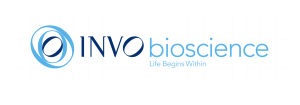
Shares of INVO Bioscience, Inc. (NASDAQ: INVO), a medical device company focused on commercializing the world’s only in vivo culture system (IVC), INVOcell®, closed at $3.29, and has risen to $3.75, +1261% in the aftermarket, but still well off of its 52-wk high of $12.30. A sell side analyst named Kyle Bauser, Ph.D. at Colliers Securities recently published his Buy Rating Report with a $6 Price Target. On Dec. 16,
INVO Bioscience, Inc. announced that it has entered into an expanded agreement with Ovoclinic, a group of clinics specialized in assisted reproductive treatments with four locations across Spain (Madrid, Marbella, Málaga, Ceuta) and collaborating centers around Europe, to accelerate adoption of INVOcell within their markets. The agreement includes the expanded adoption of INVOcell within Ovoclinic locations as well as establishing an INVO Center of Excellence for future training for the European Market. Cristina Gonzalez, embryologist and Quality Manager of Ovoclinic laboratories stated,
“After several successful trials implementing the exciting INVOcell fertility treatment, Ovoclinic aims to provide its patients with this effective alternative to the processes used so far in Spain in the field of reproductive medicine. We consider INVOcell to be an effective method of natural reproduction that involves the future mother at the very first moment of the process. We are confident that this innovative treatment will help many patients to choose this new alternative solution to achieve their dream of forming a family by actively participating in the reproductive process.” According to the World Bank, Spain, with total population of approximately 47 million people, has one of the lowest fertility rates in Europe, affecting approximately 15% of the population, or one in seven couples of reproductive ages. According to reports, in 2010, there were approximately one million couples requesting assisted reproductive treatment, however only 22% received one or more assisted reproductive treatment cycles. The average waiting time for an IUI or IVF cycle in a public health facility was 339 days. Ovoclinic reports that they maintain the best technical and human resources to deal with all kinds of infertility problems along with the simplest and most natural treatments to the most complex and advanced techniques pioneered in Spain. Ovoclinic also works in partnership with Ovobank, the first European Donor Egg Bank in Europe.
Shares of Hecla Mining Company (NYSE: HL), the largest silver producer in the United States closed at $5.16, -1.15%.
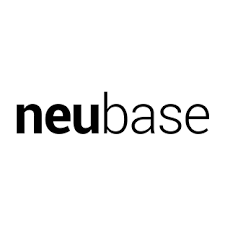
Shares of NeuBase Therapeutics (NASDAQ: NBSE), a biotechnology platform company Drugging the Genome™ to address disease at the base level using a new class of precision genetic medicines, closed at $2.95, +4.98% after hitting an intraday high of $3.11. The 52-wk range is $2.52-$12.89. On Dec. 23, NeuBase reported its financial results for the fiscal year ended September 30, 2021, and other recent developments. As of September 30, 2021, the Company had cash and cash equivalents of approximately $52.9 million, compared with approximately $32.0 million as of September 30, 2020 NeuBase estimates its current cash and cash equivalents are sufficient to fund currently planned operating and capital expenditures into the first quarter of CY2023. “NeuBase is focused on significantly reducing the burden of untreatable morbidity and mortality caused by rare and common diseases across the globe. To achieve this goal, we designed, built, and validated a new precision genetic medicines platform technology that can uniquely drug the double-stranded human genome and address disease at the root of causality without many of the limitations of early precision genetic medicine technologies. We are poised to file our first Investigational New Drug (‘IND’) applications with the U.S. Food and Drug Administration (‘FDA’) beginning in calendar year 2022 and intend to scale into additional indications with increasing speed and efficiency thereafter,” said Dietrich A. Stephan, Ph.D., Founder, Chief Executive Officer, and Chairman of NeuBase. “This past year, we validated the ability of our technology in proof-of-concept studies to directly drug the double-helix of the human genome, including difficult double-stranded structures of RNA targets, and engage with mutant genes to resolve most causal mechanisms of disease. The validation of our platform’s capabilities included data describing that we have overcome many limitations of early precision genetic medicine technologies, such as biodistribution, tolerability, selectivity, manufacturability, durability, and scalability. We also presented data that our delivery shuttle enables compounds to elicit pharmacologic effects in multiple tissues, including in the brain and muscle, after subcutaneous administration in preclinical animal models,” said William Mann, Ph.D., M.B.A., Chief Operating Officer of NeuBase. “We recently nominated the development candidate for our myotonic dystrophy type 1 (DM1) program, which we believe has the potential to be a best-in-class therapy that offers a patient-friendly route of administration, a whole-body solution for the muscle, heart, and brain manifestations of the disease. Furthermore, the mechanism of action of our development candidate is designed to engage with the toxic RNA hairpin structure to release the splicing proteins, restoring normal RNA splicing and downstream protein production, including DMPK. We have initiated IND-enabling studies for this candidate, with data read-outs expected across CY2022. We expect these data will support the submission of an IND filing to the FDA in the fourth quarter of CY2022,” stated Sandra Rojas-Caro, M.D., Chief Medical Officer of NeuBase. “As a result of the nomination of our DM1 program candidate, we established CMC expertise at our new facility in Cambridge, Massachusetts that is co-located with our clinical development team, finalized the formulation of our development candidate to enable systemic routes, and completed process development. We also scaled-up manufacturing in-house and with contract manufacturing partners to support non-clinical toxicology, product stability, and Phase 1/2 clinical trials,” said Tony Rossomando, Ph.D., Chief Technology Officer of NeuBase. Dr. Stephan concluded, “In parallel, we are making significant progress in our therapeutic program for Huntington’s disease. For example, we have illustrated with preclinical in vivo data that our proprietary delivery technology allows our genome-targeting compounds to advance beyond intrathecal delivery and enabling a systemically administered allele-selective therapy, overcoming challenges seen with other programs. Furthermore, preclinical data show that our PATrOL™-enabled compounds can silence activating KRAS point mutations in vivo to inhibit protein production, which has the potential to target G12D and G12V, the two most common and historically ‘undruggable’ cancer-driving point mutations that represent the majority of KRAS tumors. We believe these data set the stage for a potentially first-in-class precision genetic medicine approach for oncology capable of selectively targeting mutations at the single-base level.”

Shares of Seanergy Maritime Holdings Corp. (NASDAQ: SHIP), the only pure-play Capesize ship-owner publicly listed in the US. Seanergy provides marine dry bulk transportation services through a modern fleet of Capesize vessels, closed at $.925, +.72%. Seaenergy announced recently that it has entered into a definitive agreement for the refinancing of a loan facility secured by M/V Geniuship, with a new loan facility secured by the same vessel.The current outstanding balance is provided by certain nominees of Entrust Global and stands at $14.6 million. The Entrust facility has a remaining duration of 3.5 years, bears interest at a fixed rate of 10.5% per annum and amortizes through quarterly instalments of $515,000. The new loan facility will be provided by a prominent Far Eastern bank (the ‘New Facility’), has an initial balance of $15 million, a five-year term and bears interest of LIBOR + 3.5% per annum. The New Facility will amortize through 4 quarterly instalments of $530,000 followed by 16 quarterly instalments of $385,000. Stamatis Tsantanis, the Company’s Chairman & Chief Executive Officer, stated: “As part of our continuous efforts to further improve our strong cashflow, we have agreed another successful refinancing for an existing capesize vessel. The New Facility has a considerably lower interest rate, which will benefit immediately the Company’s cash flow and profitability. The total expected interest savings for Seanergy will be approximately $2.3 million over the next 3 years. Consistent with our conservative approach on leverage, we aim in achieving more competitive pricing and overall terms of the loan without increasing the debt on the vessel. We remain committed to our strategy to further reduce our financing cost by additional refinancings and buybacks or repayment of debt that are expected to generate improved shareholder returns.”
Shares of Transocean Ltd. (RIG), a leading international provider of offshore contract drilling services for oil and gas wells, closed at $3.12, +13.04%.
Shares of Immix Biopharma, Inc. (Nasdaq: IMMX), a biopharmaceutical company pioneering Tissue-Specific Therapeutics (TSTx)TM targeting oncology and immuno-dysregulated diseases, closed at $5.78., +62.36%. Today Immix announced that the U.S. Food and Drug Administration (FDA) has granted Rare Pediatric Disease (RPD) designation for IMX-110 for the treatment of a life-threatening form of pediatric cancer in children, rhabdomyosarcoma. IMX-110, an investigational product, is currently being evaluated in a Phase 1b/2a clinical trial. The FDA grants Rare Pediatric Disease designation for serious and life-threatening diseases that primarily affect children aged 18 years or younger and impact fewer than 200,000 people in the United States.



